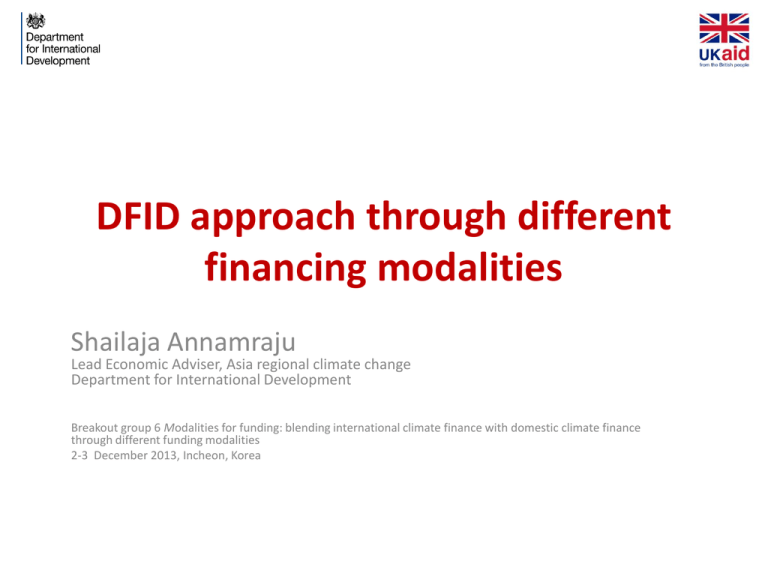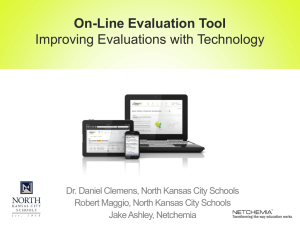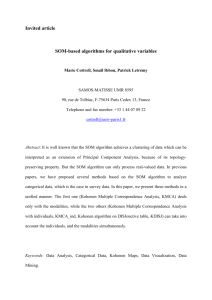Cons - Climate Change Finance and Development Effectiveness
advertisement

DFID approach through different financing modalities Shailaja Annamraju Lead Economic Adviser, Asia regional climate change Department for International Development Breakout group 6 Modalities for funding: blending international climate finance with domestic climate finance through different funding modalities 2-3 December 2013, Incheon, Korea UK climate finance modalities UK has an International Climate Fund • £3.8 billion over 5 years • Split between 3 UK Government departments (DFID, DECC, Defra) • 3 themes (50 % for adaptation, mitigation, forestry) • Spent through country regional (30%), through plurilateral (40%), and through multilateral programmes (30%). Climate finance modalities therefore are dependent on: - Overall objectives of the ICF - reducing numbers of vulnerable, harnessing financing, and getting country to move to low carbon pathways - Political economy factors within the UK government - Centralised versus decentralised financing mechanisms - Models which will bring private, public, and now domestic finance Slide 2 Getting to the right modalities . Theory of change Strategic cases/ Business cases Full transparency Challenge Fund and Board Right places Doing the right thing – learning, LCD vs poverty reduction Slide 3 Risk, VFM, Pace and Size of investment In the right way – central vs decentralised Learning and testing objectives Capacity of delivery partners and respective roles Right partners – private sector Right instruments – testing new instruments returnable capital Continuum of decentralised climate financing modalities Non-BS FA National Climate Funds Projects Topped-up Sectoral FA Forms of Budget Support Virtual CC Climate PolicyFunds Based BS Degree of flexibility so potentially greater alignment/effectiveness Pros: • allow experimentation & learning of what sorts of climate spend are most effective • ease with which UK climate finance can be tracked • fiduciary risk perceived as low Cons: • extent to which really in line with partner Govt priorities risk weak allocative efficiency? Questions: • how closely has partner govt been involved in project design? •is the project on-budget? Pros: Pros: • permit greater govt control and so should lead to greater alignment with national priorities • allow pooling with other donors so lower admin burden for donor • fiduciary risk can be lower than for budget support • ability to track •India MNREGA example Cons: • requirement to prove spending is on CC can drive sub-optimal spend • capacity demands • time take to set up Questions: • is the Fund allocated against a clear climate strategy? • is NCF on-budget? • can it fund incremental costs of CC? • should lead to greater allocative efficiency than NCF • should help with mainstreaming Cons: •Many sectors do not have SBS • fungibility means can be hard to prove additionality • greater fiduciary risks Questions: • does the sector have a clear CC strategy? Degree of earmarking Pros: • flexible support so should have high allocative efficiency • encourages mainstreaming Cons: • assumes we know what is effective climate spend • fungibility Q over additionality • fiduciary risks Questions: •Is there a national climate strategy •do systems exist to allow tracking of spend? • do credible M&E systems exist? Pros: • focus on policy dialogue means most strategic Cons: • may not generate financial data –hard to track additionality? Questions: • what size of disbursement is justified by a policy reform? Source: DFID Some programmatic instruments – in practice 1. Budget support mechanisms – 1. World Bank in Vietnam. Accounts for funds solely against agreed policy reforms. 2. Might need budget codes for tracking purposes as precursor. Bangladesh and Nepal, Vietnam – have them. Needed for counterfactual, additionality of our support, reduce fungibility, and tracking of spend. Would need full fungibility analysis 3. Opens possibility of virtual funds. 2. Results based funding. 1. May work for one donor or for a small country with a limited set of issues. 2. In Guyana – the EC is trying a results based budget support for their mangrove action plan. Payment is therefore linked to a release triggered by eg an agreed length of mangroves planted. EC does check that their funds flow to the appropriate sector. 3. Non budget Financial Assistance 1. Can be harmonised and aligned, going through government systems. 2. Often uses same mechanisms as budget support but is too tightly earmarked to meet the DAC definition of BS. Similar to common pool approaches. 3. Govt puts some of its own funds in (eg Mozambique health sector), identifies ‘projects’ within its budget – or develop them with donors, akin to the Guyanese mangrove action plan 4. Policy dialogue still possible around the effective projects. 5. Uganda renewable energy feed-in tariff another example/UN CDF LoCAL programme Continuum of central and regional financing modalities Core contribut ions Pros: • Core to the mandate of the MDBs and their knowledge role. GEF, GFDRR, IFAD Cons: • Blunt instrument for achieving cc objectives in country Questions: • Has not blended well yet with incentives. But IDA 17 cc is core UK ask. GCF/ Climate Investment Funds Pros: • Core mandate is achieving climate objectives •Creation of new institutions Cons: •Longtime to design and takes long to implement Question: Have countries been involved in design? Levels of MDB Trust Funds Plurilateral (multicountry/ multi partner) Pros: Pros: • Even more targeted. Can be more specific about results. Good testing ground.UCCRP, SAWI Creating new regional/global institutions Cons: Can be blunt instruments to achieve objectives •Not core to MDB mandate and still strongly lending modality Questions: Develop scaled up models Cons: Not aligned with country •How do your ensure political will through these prog influence, earmarking Multilateral funds in country Pros: •MDB administered, multi-sectoral. Eg BCCRF, CHIP in Ethiopia Cons: •Takes long to setup and implement. Questions: - Increasing accountability, and legitimacy of these funds Some examples Climate Proofing Growth and Development Problem – All countries trying to integrate cc into planning, investments and budgets. Programme: Regional learning programme on help 5 countries, £28.5m. Shared regional technical assistance facility, national units, and government steering committees Potential issues: Need for flexibility, broad scope, establishing Ministry leads, Prioritisation Adaptation for Small Scale Agriculture Production Problem – The costs of not adapting agriculture to climate could be about 5% of world's GDP by 2050. Smallholder farmers in developing countries are already at risk from climate variability Programme – £150m, through IFAD helping 6m farmers. Investing in practices and knowledge and access to markets and information to help smallholder farmers adapt to climate change. Working with governments on policies. Blending issues Blending this money with IFAD programmes so need for incremental costs to be identified. Climate Public Private Partnerships Problem: Developing countries lack viable and cost-effective access to capital markets and financial expertise needed to properly invest Programme: £130 m through 2 private equity funds, 20,000 jobs and clean energy sources expected. The aim of CP3 is to demonstrate to the private sector that climate friendly investments in developing countries are financially viable. Issues - Central lending mechanism can they delivery on CC. Urban Climate Change Resilience Partnership Problem: In densely-populated cities with rising populations in Asia, without proactive plans and investments, poor and vulnerable people will struggle to cope with even heavy rainfall, let alone extreme weather events. Programme: $145m in partnership with ADB, RF, USAID helping 2 m urban poor by improving integrating cc into city planning processes, investing in practical measures and in mobilising domestic/international finance for resilient infrastructure projects in 25 cities in 6 countries in Asia. Blending issues – Capacity and governance of municipalities, how municipalities are financed and ability to borrow will be key. 7 Blending international/country finance modalities – some observations Objectives Clear objectives of what you want to achieve and how you can get there. Start with the problem and framing of options. Portfolio of spend needs to shift from centralised to decentralised mechanisms Governance Better to have climate finance managed by an autonomous multi-stakeholder government steered body. Most countries have fragmented climate finance. Choose modality which is channeled through systems to reduce burden on government. Often modality is picked because of lack of donor resources to manage. Shape of current mechanisms are correlated with donor capacity, government and partner capacity but not if your ability to manage is less. Level of government coordination and donor coordination is just beginning. Coordination capacity with various line agencies at local level is also needed. Capacity to design and manage new financing mechanisms MoEF experience of managing international finance, not been their mandate till recently. Strengthen Ministry of Finance ability to monitor domestic and international climate finance – expenditure coding, tracking etc Blending international and domestic finance At the multilateral level – need to strengthen The expertise and capacity of even the MDBs to have the right incentivises to deliver climate change are not there Private sector Bringing in the private sector is not an add on objective Tensions exist between the constraint of country ownership/political buy-in versus commercial decision making. Risk sharing: how far should the public sector go to make a project financially viable? Do we need more decentralised approaches for increased private sector models for eg. to support SMEs? Procurement co-ordination: a hundred country-level solar buying projects… How to maximise effectiveness, avoid duplication, centralise accessible expertise New instruments for learning, for scale up, for franchising and for regional public goods. Regional public goods: Role of donors in regional cooperative solutions/ what modalities exist? Scope for corruption with the rise of so many new climate finance modalities – thinking through the checks and balances. Monitoring and evaluation Coordinate to reduce unnecessary duplication of effort in measuring results









